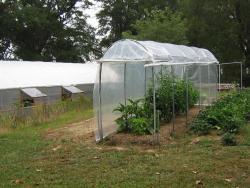I'm going to try to develop some information for an article that compares USDA zones, days to maturity, and another measure of the growing season, growing degree days.
A very short explanation is that growing degrees are a measure of time above a certain temperature as it affects the growing season of a plant and its maturity. The difference in growing degrees can explain why one type of tomato matures in 65 days in one location and in 75 days somewhere else. It's why a Texas zone 8b is not the same as an Oregon zone 8b.
To make the article meaningful, I would like to include some example tomato cultivars and the growing degree days for those types. I'd also like to correlate the GDD with days to maturity. Here's where I'm asking for help.
If you have records for any tomato cultivars that includes transplant date, first harvest date, and zip code where planted, I would like to collect that data. I can use weather records in online GDD calculators to estimate the value. If I can get a few different sets of data for common types of tomato then I can calculate average DGG for those varieties. Those growing degree days numbers can be translated to any other area and will give a better estimate of maturity than the standard days to maturity.
To summarize: send me the cultivar name, transplant date, first harvest date, and zip code.
For example: Big Beef, 03/01/2013, 05/18/2013, 78660
David Reaves


